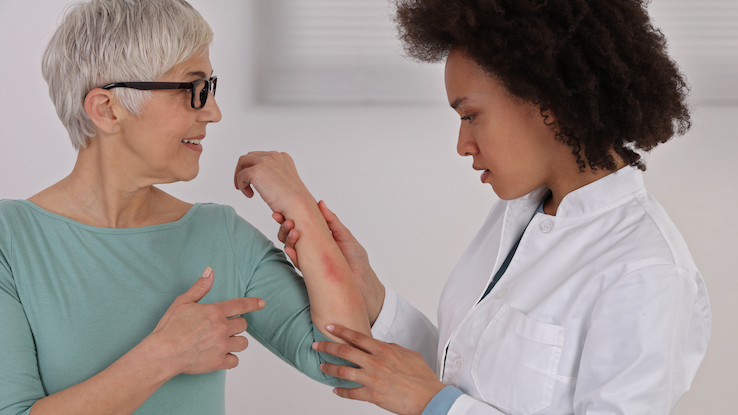
Hidradenitis suppurativa (HS) is a chronic inflammatory skin condition that can cause painful lumps, pockets of pus, odorous draining tracts, and scarring of the skin to develop. This usually occurs in places where there’s skin-on-skin contact, like under the armpit or in the groin. While HS isn’t rare – anywhere from 0.03% to 4% of the global population may have the condition – many people aren’t aware of hidradenitis suppurativa. As a result, they may assume that their symptoms are related to another medical concern.
By understanding the symptoms of HS, it’s easier to see how this condition stands apart from other skin concerns. Additionally, it can make deciding when to see a doctor easier. Here’s what you need to know.
Early and Progressive Symptoms
According to the American Academy of Dermatology (AAD) Association, HS leads to lumps that typically develop in areas on the body where skin contacts skin, such as in the armpits, the inner thighs, and the groin. Usually, one of the earliest signs is breakouts that resemble pimples, though they may also look like boils. In some cases, simple discomfort and slight swelling of the skin may be one of the earlier indications of HS. A burning or itching sensation may also occur, as well as excessive swelling. As the condition progresses, additional nodules can develop and, in time, may grow together, leading to abscesses. An abscess is a collection of pus under the skin.
As an abscess grows, it can rupture, causing pus and blood to flow out. The leakage can have a foul odor.
Abscesses typically heal slowly, if they heal at all. This healing process results in scarring of the skin. Many abscesses will come back, too. In severe cases, tunnels between the abscesses can form beneath the skin. These are called “sinus tracts.”
Treating Hidradenitis Suppurativa
Without treatment, HS typically comes back and gets worse. While nodules may initially heal, they often reappear, and when that occurs, they usually worsen.
Treatment begins with an exam from your doctor to diagnose the HS. Once diagnosed, a dermatologist can work with you to develop a plan to reduce symptoms, treat infections, prevent disease progression, and control your pain.
Usually, treatment involves a combination approach. Your doctor may prescribe you topical antibiotics that are applied directly to the affected skin in order to treat or prevent infection. You may get steroid injections to reduce the swelling of your lesions. You may get hormone treatments to reduce the development of lesions if your doctor thinks your case is related to hormone levels.
Lifestyle changes are also an important component of treatment, including a skincare routine designed to limit irritation, avoiding tight clothes, and avoiding harsh skincare products. Your doctor will talk with you about how to dress your wounds, which will usually be with petroleum jelly or gauze, and not with adhesive bandages. And your doctor will work with you to control your pain, which can often be accomplished with topical creams or oral anti-inflammatory medications, such as acetaminophen or ibuprofen.
Depending on the severity of your HS, your doctor may recommend a procedure or surgery to address your lesions. This is often an incision and drainage or a surgical excision. These procedures are designed to clear out or remove the affected tissue.
For some people, HS can have a psychological impact. It’s important to know that this is not caused by poor hygiene or anything that you did wrong. It’s also not contagious. Your doctor may be able to recommend counseling or support groups to help you manage the impacts of HS on your quality of life.
When Should You See a Doctor?
In most cases, early diagnosis of HS is ideal as it allows for treatment to begin as soon as possible. If you experience inflammation or lump development that is painful, doesn’t improve on its own, recurs after treatments, appears in several locations, worsens over time, leads to scarring, or flares up often, it’s best to have it checked by your doctor. Similarly, if there is any sign of infection, like fever, swelling, or redness, make an appointment with your doctor as soon as possible.
Further Reading
- Ballard K, Shuman VL. “Hidradenitis Suppurativa.” [Updated 2022 Jul 15]. In: StatPearls [Internet]. Treasure Island (FL): StatPearls Publishing; 2022 Jan-. Available from: https://www.ncbi.nlm.nih.gov/books/NBK534867/
- Calao M, Wilson JL, Spelman L, Billot L, Rubel D, Watts AD, Jemec GBE. Hidradenitis Suppurativa (HS) prevalence, demographics and management pathways in Australia: A population-based cross-sectional study. PLoS One. 2018 Jul 24;13(7):e0200683. doi: 10.1371/journal.pone.0200683.
- Ludmann P. “Hidradenitis Suppurativa.” American Academy of Dermatology Association. Last updated 03 May 2022. https://www.aad.org/public/diseases/a-z/hidradenitis-suppurativa-symptoms





